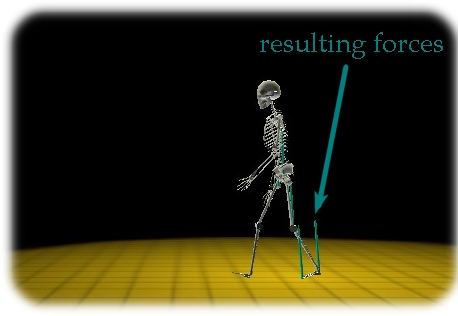Validating retargeted and interpolated locomotions
by dynamics-based analysis
| Nicolas Pronost | Georges Dumont |
| University of Rennes 1 | ENS Cachan |
| IRISA - SIAMES | IRISA - SIAMES |
Abstract :
Retargeting and interpolation methods may introduce physical inaccuracies in virtual human animation. This paper presents a method for evaluating the dynamical correctness of retargeted and interpolated motions. We determine resulting forces and torques at joints, with special attention to the ground reaction forces. With this intention, we propose an automatic creation of the biomechanical model of the character upgraded with the masses and inertias of the limbs and the motion mapping on this model. Then using support phase recognition, we compute resulting forces and torques by an inverse dynamics method. We evaluate how the retargeting and the interpolation methods change the physics of the motions by using the results of our analysis on artificial and real motions and using literature and experimental data from force plates. Our evaluation relies on the study of several retargeting and interpolation parameters such as the global size of the character, the relative ratios of limbs, the structure of the model, the length of step, the motion style and the character velocity.
Keywords :
Motion analysis - Dynamics-based validation - Biomechanics
Paper :
International Conference on Computer Graphics and Interactive Techniques (GRAPHITE) 2006 - Paper :
BibTeX :
@inproceedings{PD06c,
author = {N. Pronost and G. Dumont},
title = {Validating retargeted and interpolated locomotions by dynamics-based analysis},
booktitle = {4th International Conference on Computer Graphics and Interactive Techniques in Australasia and South-East Asia (GRAPHITE), Kuala Lumpur - Malaysia},
pages = {65-74},
year = {2006},
month = dec,
series = {ISBN: 1-59593-564-9}
}
Video :
Validating retargeted locomotion by a biomechanical skeleton and dynamics analysis. Presentation of the validation method for retargeted motions by dynamics analysis using a joint-angle model of a skeleton improved by biomechanical data.
This video shows kinematically generated locomotions which are tagged as physically invalid by our algorithm. The original locomotion (upper left) and 3 motions generated by "too large" parameters.
This video shows forces acting on the limbs in a jumping motion.
This video shows forces acting on the limbs in a running motion.
This video shows forces acting on the limbs in a walking motion.
